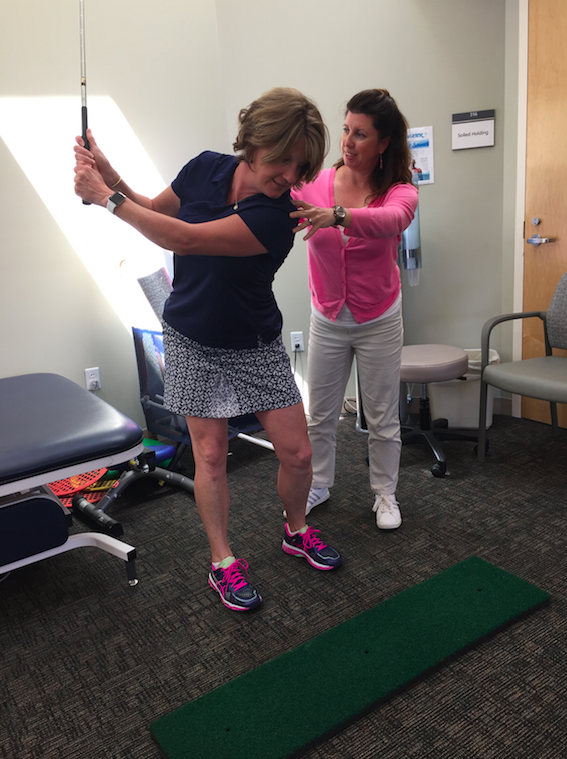IMPROVE MY GAME
Articles
How I Use Dry Needling And My TPI Medical Certification To Help Golfers

Although I have been treating golf-related injuries for over 15 years, it is within the last two years that I have seen dramatic results in recovery and improved performance without pain, using Integrative Dry Needling (IDN) in my physical therapy practice. Before using dry needling, I would rely on the traditional physical therapy tool box of manual and therapeutic skills including joint mobilization, trigger point massage, active release stretching, cupping, foam rolling, etc. By incorporating IDN’s neurologic dry needling techniques into my treatment regime, I have found that many golfers are responding even faster to treatment and are back out on the course sooner. This modality has been a great adjunct to the golf program I have helped to develop at Cape Cod Healthcare, where I practice as a TPI Level 3 Certified medical expert. The program through TPI has taught me the skills to effectively evaluate and treat golf injuries, as well as prescribe performance-based golf exercise programs that directly enhance a player’s performance.
To use dry needling effectively for golf injuries, it is imperative to understand the mechanics of the golf swing and to know what muscles and joints are being used. The golf swing is a complicated movement of spinal twisting, loading, and compression, and most joints in the body are affected by the swing. It’s a repetitive motion by nature and barely lasts a second, potentially producing a tremendous amount of torque and pressure on the spine. Even elite Tour players, who have a more efficient swing and are, on average, in better golf shape than most amateurs, suffer from repetitive strain injuries.

Oftentimes, amateur players who have a less efficient swing and who are not as committed to a fit golf body are even more vulnerable to injuries associated with wear and tear from the golf swing. Statistically speaking, back injuries are the most common golf injuries and that ailment I most frequently see in our clinic.
RELATED ARTICLE: Important Considerations For Golfers Undergoing Rehab Following Back Surgery
I find that the neurologic dry needling technique that the IDN Institute teaches really fits into my current clinical framework for treating golf clients. My physical therapy training in orthopedics emphasizes global functional movement and how all the moving parts work together to form a proper synergistic pattern. In other words, no moving joint can operate efficiently unless it can count on another joint to stabilize properly around it. The same synergistic philosophy goes for IDN’s dry needling treatment approach. The technique I use not only addresses the painful area, but other areas in the body that may be causing the pain.
Using this global framework, it’s important to not just “chase the pain” when selecting dry needling points with golfers. For example, when treating a golfer’s back pain, I perform a series of selected functional movement tests to tease out faulty movement patterns that may have been contributing to their pain. Those medical professionals who have attended TPI Medical Level 2 and Level 3 will be familiar with this approach. This is also an essential step in being effective with dry needling. TPI Certified professionals are aware that pain in the lower back is often a result of poor hip, thoracic, or pelvic mobility, causing golfers to “steal” motion from the back to make a proper back swing and follow through. So, once the movement problem is identified (which may or may not be originating from the back), I can treat the contracted back musculature with dry needling, as well as the surrounding tissue trigger points in other restricted areas. I, then, typically perform the appropriate joint mobility techniques to the hip or pelvis, or wherever the dysfunction lies, to restore proper movement. This holistic approach takes care of the back pain, but also helps to prevent it from coming back.
After the first treatment with dry needling, where I may only target four to six neuromuscular trigger points, most golf clients can immediately feel a difference in their tissue, and many notice less spasm and pain after the first session. This type of response not only makes the patient feel better, but also allows me to progress them at a quicker pace through the movement corrective exercises they need to fix the mechanical issue. My clients are then back on the golf course quicker, and I’m finding that many are able to play four to five times a week without becoming incapacitated from muscle spasms that would normally have them missing rounds.

While the dry needling technique is not a panacea for all golf injuries, nor is it a modality that I use in exclusion of other evidenced-based physical therapy treatments, it is a powerful tool to have in my practice.

Catherine Hoell, PT, DPT, OCS, is a physical therapist specializing in orthopedics and golf rehabilitation. She received her doctorate degree from Massachusetts General Hospital Institute of Health Professions in Boston, and is board certified in Orthopedics. Dr. Hoell is a lead physical therapist at Cape Cod Healthcare and is TPI certified Medical Level 3.